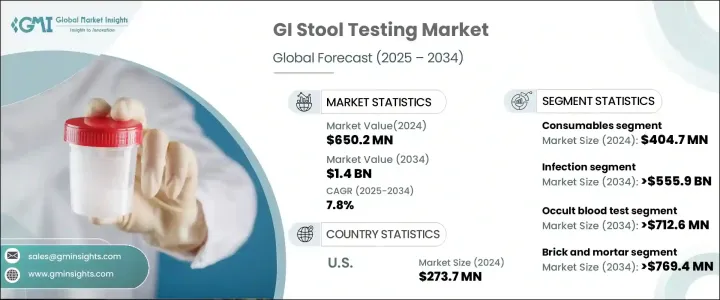
세계의 GI(위장) 대변 검사 시장은 2024년에 6억 5,020만 달러에 이르렀으며, 2025년부터 2034년까지 연평균 성장률(CAGR) 7.8%로 성장할 것으로 예측됩니다.
위장 장애의 유병률 증가, 예방 의료에 대한 인식의 증가, 진단 기술의 지속적인 발전이 이러한 성장의 주요 원동력입니다. 소화기 건강에 대한 관심이 높아지면서 의료 서비스 제공자들은 비침습적이고 효율적인 대변 검사 방법을 일상적인 검진에 적극적으로 도입하고 있습니다. 이러한 광범위한 채택은 대변 기반 진단 도구의 정확성, 경제성 및 접근성이 향상되어 조기 질병 발견의 필수 요소로 자리 잡음으로써 더욱 뒷받침되고 있습니다.

소비자들은 점점 더 사전 예방적 건강 관리를 우선시하고 있으며, 이에 따라 불편함을 최소화하면서 신뢰할 수 있는 결과를 제공하는 대변 기반 진단에 대한 수요가 증가하고 있습니다. 가정 기반 검사 솔루션으로의 전환도 시장 확대에 기여하고 있으며, 개인이 병원을 자주 방문하지 않고도 편리하게 검사를 수행할 수 있게 되었습니다. 또한 대장암 검진 프로그램과 의료 환경에서의 감염 관리 조치를 장려하는 정부 전략은 우호적인 규제 환경을 조성하고 있습니다. 또한 전 세계적으로 의료 인프라가 지속적으로 확장되면서 첨단 진단 솔루션에 대한 접근성이 확대되고 있는 것도 시장의 성장에 도움이 되고 있습니다. 연구 개발 노력이 가속화됨에 따라 AI 기반 분석 및 바이오마커 기반 대변 검사와 같은 새로운 기술이 진단 정확도를 향상시켜 시장의 성장 궤도를 더욱 강화하고 있습니다.
| 시장 범위 | |
|---|---|
| 시작 연도 | 2024년 |
| 예측 연도 | 2025-2034년 |
| 시작 금액 | 6억 5,020만 달러 |
| 예측 금액 | 14억 달러 |
| CAGR | 7.8% |
소모품 부문은 시약, 테스트 키트, 샘플 수집 도구와 같은 필수 진단 구성 요소를 포함하여 2024년에 4억 470만 달러에 달할 것으로 예상됩니다. 이러한 품목은 정확하고 효율적인 검사를 보장하는 데 중요한 역할을 하므로 실험실과 의료 시설 전반에서 꾸준히 수요가 발생합니다. 일회용 소모품은 오염 위험을 줄이고 엄격한 감염 관리 기준을 유지하는 데 효과적이기 때문에 점점 더 인기를 얻고 있습니다. 의료 서비스 제공자들이 계속해서 정밀도와 신뢰성을 우선시함에 따라 고품질 진단 소모품에 대한 의존도는 더욱 높아질 것으로 예상됩니다. 또한 유통망이 확대되면서 이러한 필수 구성품에 대한 접근성이 개선되어 진단 절차가 원활하게 이루어지고 있습니다.
다양한 검사 유형 중에서 잠혈 검사가 시장을 선도하고 있으며 CAGR 8.7%로 2034년까지 7억 1,260만 달러에 달할 것으로 예측되고 있습니다. 이러한 검사는 대장암과 위장관 출혈을 조기에 발견하여 진단 및 치료 결과를 크게 개선하는 데 필수적입니다. 대변 샘플에서 숨겨진 혈액의 흔적을 식별할 수 있기 때문에 국가 검진 프로그램의 중요한 구성 요소입니다. 잠혈 검사의 경제성과 비침습적 특성으로 인해 환자의 참여도가 높아져 질병의 조기 개입을 지원합니다. 의료 서비스 제공자들이 사전 예방적 질병 관리를 강조함에 따라 이러한 검사에 대한 수요는 계속 증가하고 있습니다.
미국의 GI 대변 검사 시장은 2024년 2억 7,370만 달러로 평가되었으며, 2034년까지 연평균 성장률(CAGR) 7.3%로 성장할 것으로 예측됩니다. 미국의 선진화된 의료 인프라와 예방 치료에 대한 높은 관심은 시장 확대를 이끄는 주요 요인입니다. 대장암 검진에 대한 보험 적용 범위가 확대되면서 대변 검사 솔루션의 도입이 가속화되어 질병 조기 발견의 중요성이 더욱 강조되고 있습니다. 진단 도구의 지속적인 발전과 개인 맞춤형 의료에 대한 강조가 증가함에 따라 미국 시장은 혁신적이고 접근성이 뛰어난 검사 솔루션을 통해 환자 치료 결과를 개선하면서 지속적인 성장을 이어갈 것으로 전망됩니다.
The Global GI Stool Testing Market reached USD 650.2 million in 2024 and is projected to expand at a CAGR of 7.8% between 2025 and 2034. The increasing prevalence of gastrointestinal disorders, rising awareness of preventive healthcare, and ongoing advancements in diagnostic technologies are key drivers behind this growth. As digestive health gains more attention, healthcare providers are actively incorporating non-invasive and efficient stool testing methods into routine screenings. This widespread adoption is further supported by the enhanced accuracy, affordability, and accessibility of stool-based diagnostic tools, making them an integral part of early disease detection.

Consumers are increasingly prioritizing proactive healthcare, fueling demand for stool-based diagnostics that provide reliable results with minimal discomfort. The shift towards home-based testing solutions is also contributing to market expansion, allowing individuals to conduct screenings conveniently without frequent hospital visits. Additionally, government initiatives promoting colorectal cancer screening programs and infection control measures in medical environments are creating a favorable regulatory landscape. The market is also benefiting from the continuous expansion of healthcare infrastructure worldwide, ensuring broader accessibility to advanced diagnostic solutions. As research and development efforts accelerate, emerging technologies such as AI-driven analysis and biomarker-based stool tests are enhancing diagnostic accuracy, further strengthening the market's growth trajectory.
| Market Scope | |
|---|---|
| Start Year | 2024 |
| Forecast Year | 2025-2034 |
| Start Value | $650.2 Million |
| Forecast Value | $1.4 Billion |
| CAGR | 7.8% |
The consumables segment accounted for USD 404.7 million in 2024, encompassing essential diagnostic components such as reagents, test kits, and sample collection tools. These items play a crucial role in ensuring accurate and efficient testing, leading to their consistent demand across laboratories and healthcare facilities. Single-use consumables are becoming increasingly popular due to their effectiveness in reducing contamination risks and maintaining strict infection control standards. As healthcare providers continue prioritizing precision and reliability, the reliance on high-quality diagnostic supplies is expected to grow. Expanding distribution networks are also improving access to these essential components, facilitating seamless diagnostic procedures.
Among various test types, occult blood tests are leading the market, with projections to reach USD 712.6 million by 2034 at a CAGR of 8.7%. These tests are essential for detecting colorectal cancer and gastrointestinal bleeding at an early stage, significantly improving diagnosis and treatment outcomes. Their ability to identify hidden traces of blood in stool samples makes them a critical component of national screening programs. The affordability and non-invasive nature of occult blood tests encourage higher patient participation, supporting early disease intervention. As healthcare providers emphasize proactive disease management, demand for these tests continues to rise.
U.S. GI stool testing market was valued at USD 273.7 million in 2024 and is projected to grow at a CAGR of 7.3% through 2034. The country's advanced healthcare infrastructure and strong focus on preventive care are key factors driving market expansion. Increased insurance coverage for colorectal cancer screenings has accelerated the adoption of stool testing solutions, reinforcing the importance of early disease detection. With continuous advancements in diagnostic tools and a growing emphasis on personalized medicine, the U.S. market is poised for sustained growth, ensuring improved patient outcomes through innovative and accessible testing solutions.